More than two real manufacturing companies, the Spiro-Sub first and the Aer-Sub later, were two specific trademarks created by Cressi and used in the distribution and in the sales of diving products manufactured by other Italian and international firms.
Cressi, the first Italian company for the production of “sports” diving gear, was founded before of the second world war mainly to serve the initial spearfishing divers community. Some of them had the chance of using the very first gear manufactured in France (specifically goggles, masks, fins and spearguns). The company from Genoa was involved for a long time in the manufacturing of these products also starting from the end of the second world war and until the end of the ’50 years.
The only significant experience of Cressi in the underwater breathing devices was limited to the oxygen rebreather (widely known as A.R.O. in Italy), an equipment which was deeply reviewed and improved by the Genoese company specifically for sports and training purposes, starting from the military models used during the second world war from the Italian Navy manned torpedoes and frogmen.
When also in Italy the sports diving market started to significantly develop at the end of the ’50 years, Cressi had to manage the lack of gear of his own production, in some specific categories, through manufacturing on license or simple distribution agreements of products coming from other Italian and foreign manufacturers.
The most important agreement was that with the French firm La Spirotechnique, a company owned by the French Air Liquide group and created to produce and distribute the famous Cousteau-Gagnan SCUBA units. The commander J. Y. Cousteau himself was the president of the French company for a long time. These SCUBA regulators landed in Italy through the Salvas company in Rome. This firm had started the distribution of the first Cousteau-Gagnan double-stage model, identified by the commercial name of “Acquasub”, starting from 1954 and then, two years later, of the more famous “Mistral” single-stage regulator.
This cooperation relationship with Salvas ended in 1958 (probably due to the poor sales results achieved so far) and immediately Cressi was ready to take over.
This operation was concluded in 1959 and namely through the Spiro-Sub trademark which, from that time, started to appear in many advertising flyers from Cressi (see Fig. 1 and Fig. 2). The selection of the Spiro-Sub mark itself would seem to be based on the similarity with the name of the Cousteau’s company.
As you can see from the different addresses printed on the flyers, the two companies (Cressi and Spiro-Sub) remained always separated and we can imagine that the Spiro-Sub headquarters was a kind of commercial office, warehouse and shipping center rather than a real factory.
As already done by Salvas for the “Italian” models of the Cousteau-Gagnan scuba units, Cressi probably chosen a mixed solution with both assembly of original parts and customization of some regulator’s components. This represented the cheapest solution already followed in many countries, included the USA with the US Divers, for the limitation of the customs duties. These duties were much lower for goods travelling as loose parts instead of as final products. Taking advantage from his main know-how on plastic and rubber parts, widely used on many Cressi products, the customized parts of the Mistral regulator were the mouthpieces (in both basic and snorkel provided version) and the exhaust valve located inside the regulator’s main body(fig. 3 - 4 - 5 - 6).
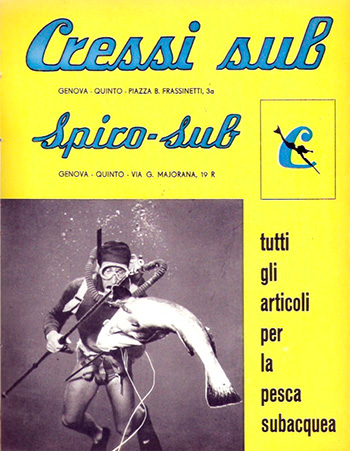 |
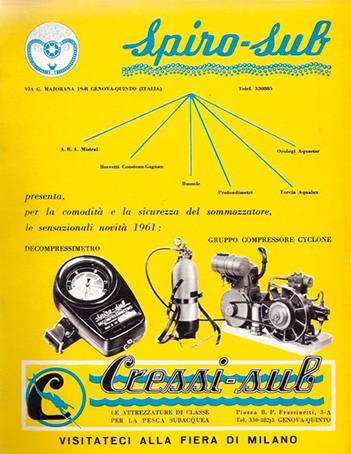 |
| fig. 1 | fig. 2 |
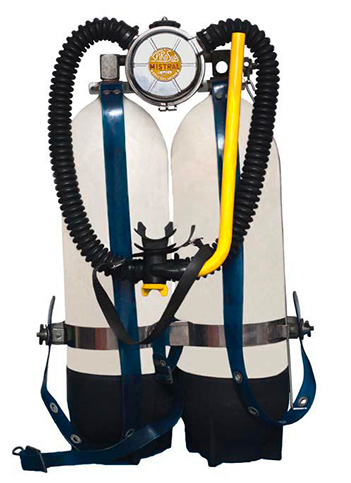 |
 |
| fig. 3 | fig. 4 |
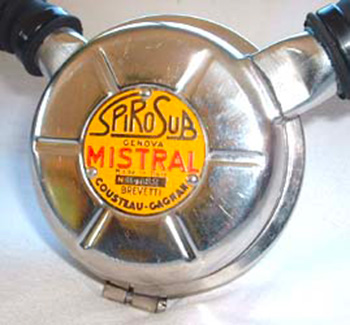 |
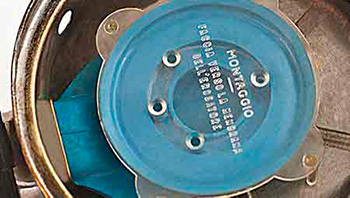 |
| fig. 5 | fig. 6 |
Off course the Mistral regulator was the most important product but it was not the only one for sure. The main target was to complete the offer for the whole range of products concerning the air self-containing diving gear, an area where Cressi was undoubtedly behind the other competitors. And indeed the products distributed by the Spiro-Sub were mainly those included in the very complete French company’s price list. These items were depth gauges, dive watches, compasses, air compressors, dive lights, etc. (fig. 7 - 8 - 9).
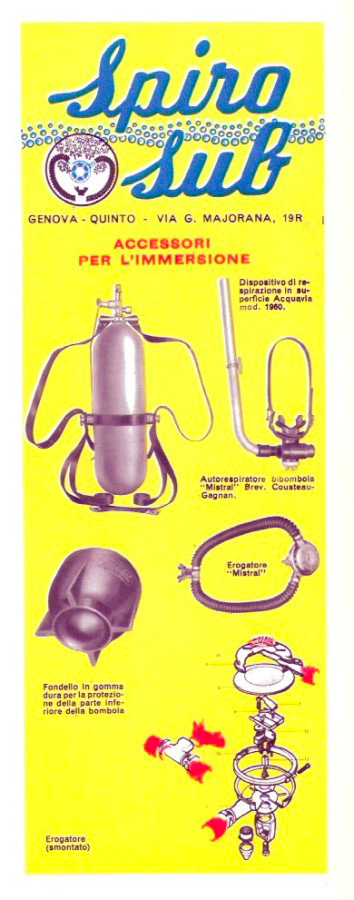 |
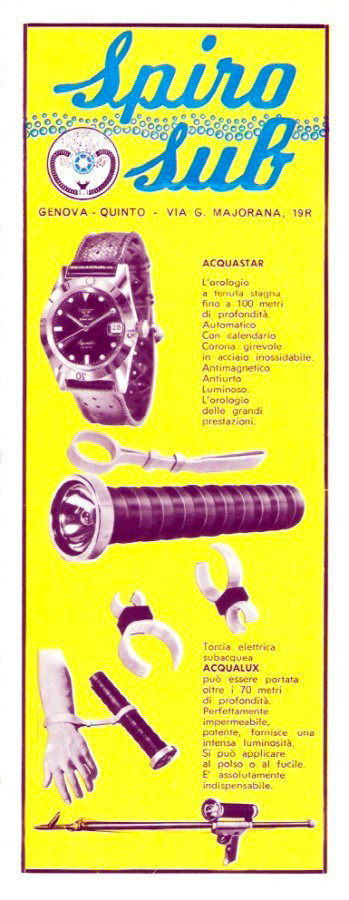 |
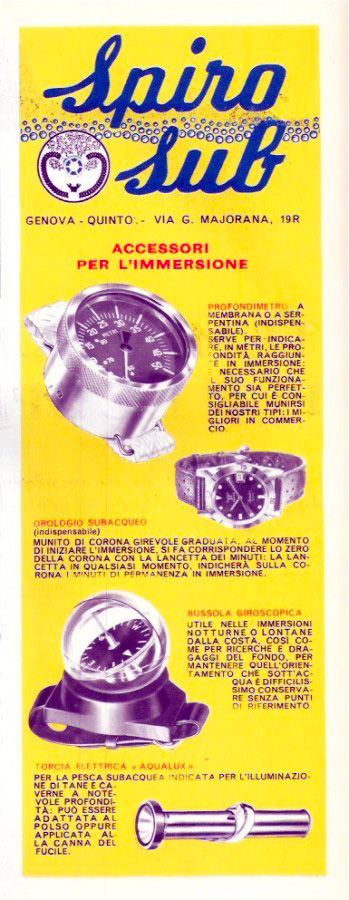 |
| fig.7 | fig.8 | fig.9 |
Unfortunately the Cressi-La Spirotechnique relationship, through the Spiro-Sub, lasted just three years and precisely until 1962 when the MOVM (Military Golden Medal Decorated) Prof. Luigi Ferraro, together his son Italo and his business partners Carlos Reinberg and Paolo Ruggero, founded the Technisub company. From that time, considering the strong and nice friendship Ferraro had with commander Cousteau (both of them contributed to establish the CMAS in 1959 and were among their most important leaders), the French company tightly engaged with Technisub which became the official Italian exclusive dealer for the whole production goods of the French company. From that time on, the Mistral first and the Royal Mistral later, were sold in Italy by Technisub in the same standard configurations offered by La Spirotechnique.
After this event off course the Spiro-Sub trademark did not have any reason to exist any longer and therefore Cressi decided to modify that in Aer-Sub by maintaining however the same mission of sales and distribution of products coming from other manufacturers. And indeed the advertising flyer shown in fig. 10 clearly says “Aer-Sub already Spiro-Sub”.
Regarding the SCUBA regulators, the products from La Spirotechnique were replaced by those coming from Scubapro, the famous US company purchased by Gustav Dalla Valle and by Dick Bonin from Healthways in 1963 . They got the company when it was very close to bankrupt and were able to re-launch it with great results. In fact, one of the first model distributed by Aer-Sub was the Scubapro R108/MK 2 model, as you can see in the flyer shown in fig. 11.
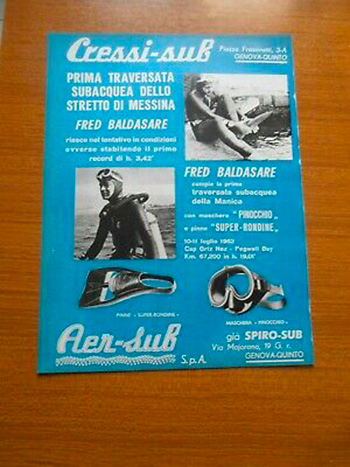 |
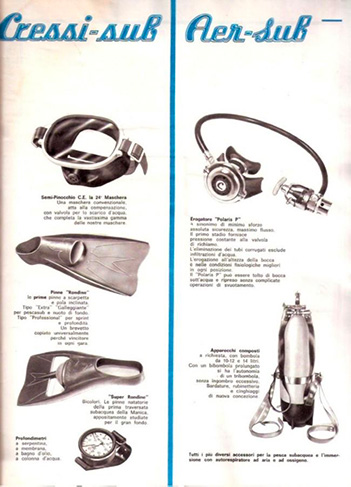 |
| fig. 10 | fig. 11 |
Probably Egidio Cressi, with this distribution agreement, took advantage of the good relationship with Gustav Dalla Valle an Italian immigrated in the USA who, before of purchasing Scubapro, was responsible of the distribution of the Cressi products in the USA during the ’50 years.
This regulator is identified in the flyer with the name of “Polaris P” but it is basically identical to the Scubapro R108 second stage with the MK2 first stage, as shown in the fig. 12 - 13 - 14 - 15.
 |
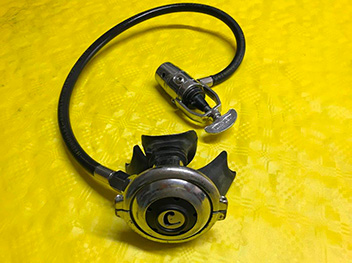 |
| fig. 12 | fig. 13 |
 |
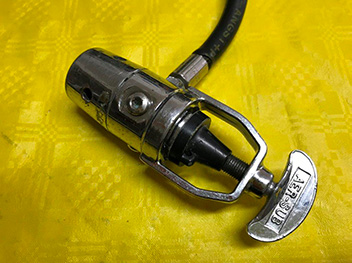 |
| fig. 14 | fig. 15 |
As you can see in the pictures above, Cressi did not give up this time either to customize this product by his brands. In particular, the customized components installed on this Italian regulator were the Cressi logo in the center of the second stage air purge button, the air exhaust plastic duct, which was a bit longer than the original one, and the Aer-Sub trademark casted on the first stage yoke screw.
This experience was fundamental for Cressi which started to develop his own knowledge on the dive air regulator technologies until the decision to start the production of his own regulators, only few years after the start of this collaboration.
The other products distributed by Aer-Sub were submitted to some customization as well. You can see for instance the air shut-off valve knob provided with Aer-Sub trademark on the twin-tanks set (with tanks produced by Dalmine) shown in the Figures 16 and 17 . This knob is identical to that provided with Cressi trademark and used on the valves of the small oxygen tanks installed on the Cressi oxygen rebreathers (ARO) (see Fig. 18 and Fig. 19).
Although we don’t have reliable information on this subject, we can imagine that the Aer-Sub trademark has been maintained by Cressi at least until 1965, the year when Cressi started the distribution of his own air SCUBA units with his first model Polaris IV (basically an evolution of the Scubapro R108/MK2 regulator).
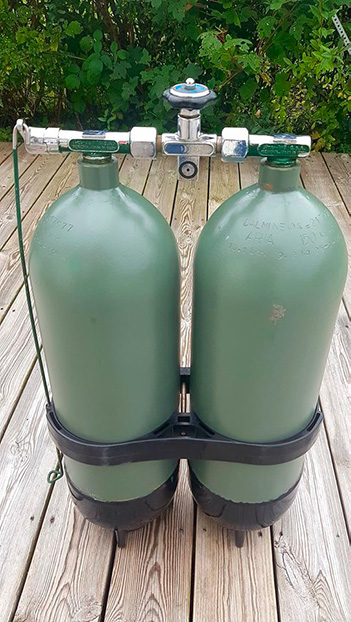 |
 |
| fig. 16 | fig. 17 |
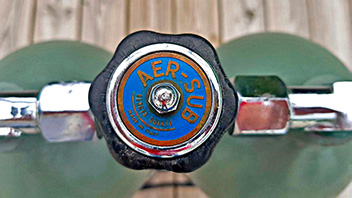 |
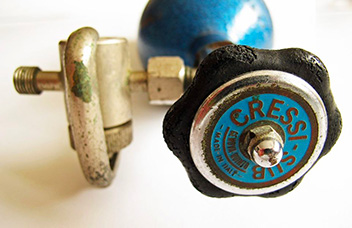 |
| fig. 18 | fig. 19 |